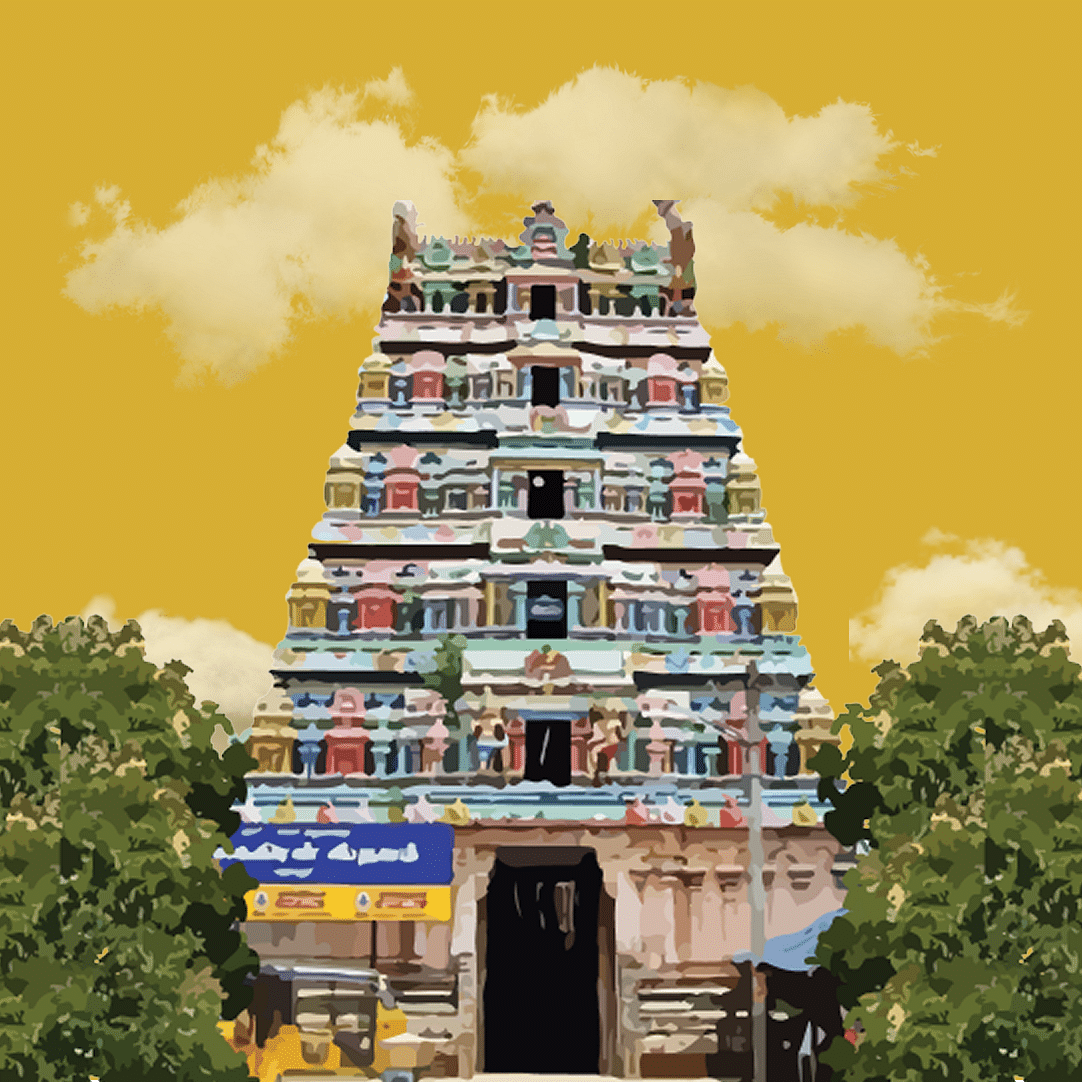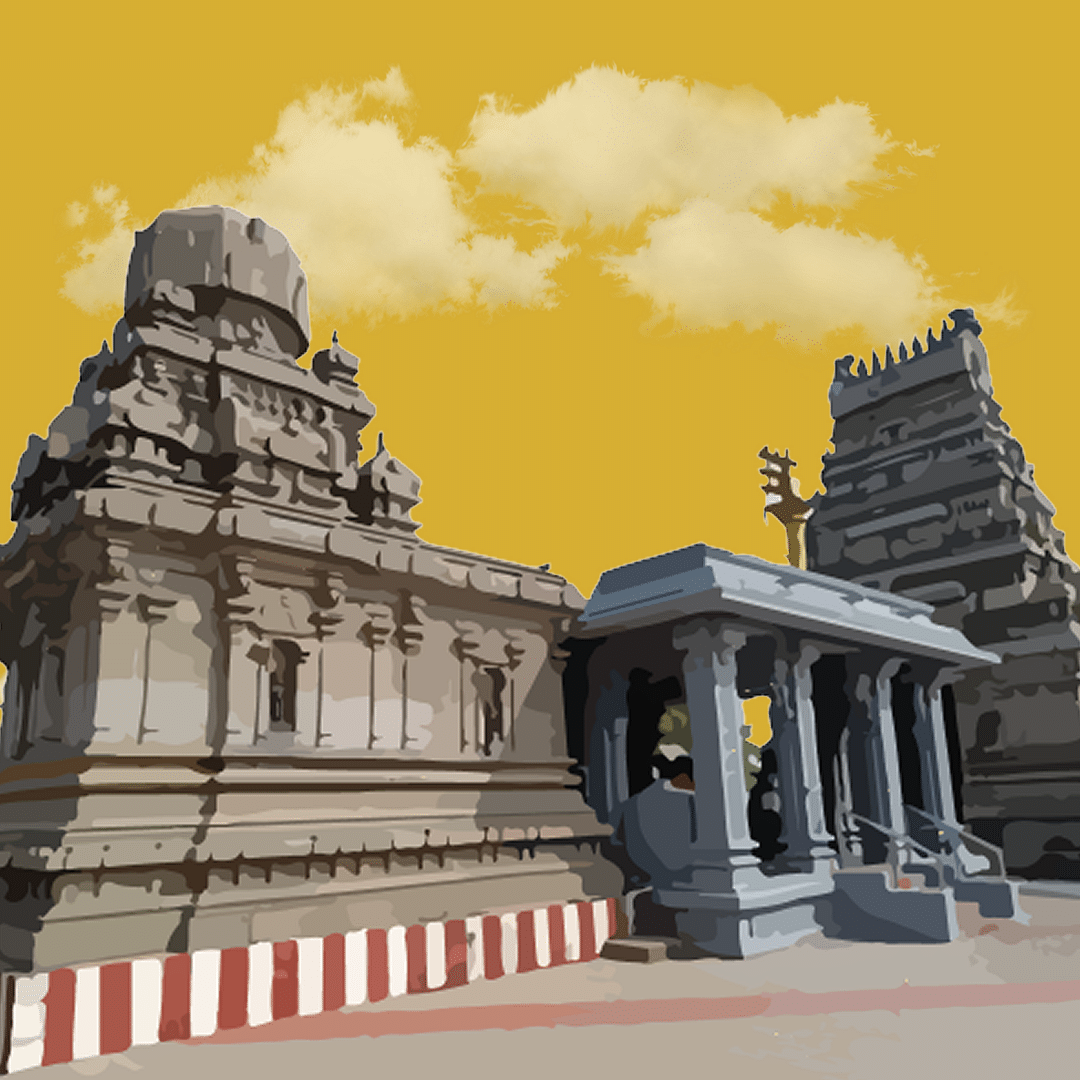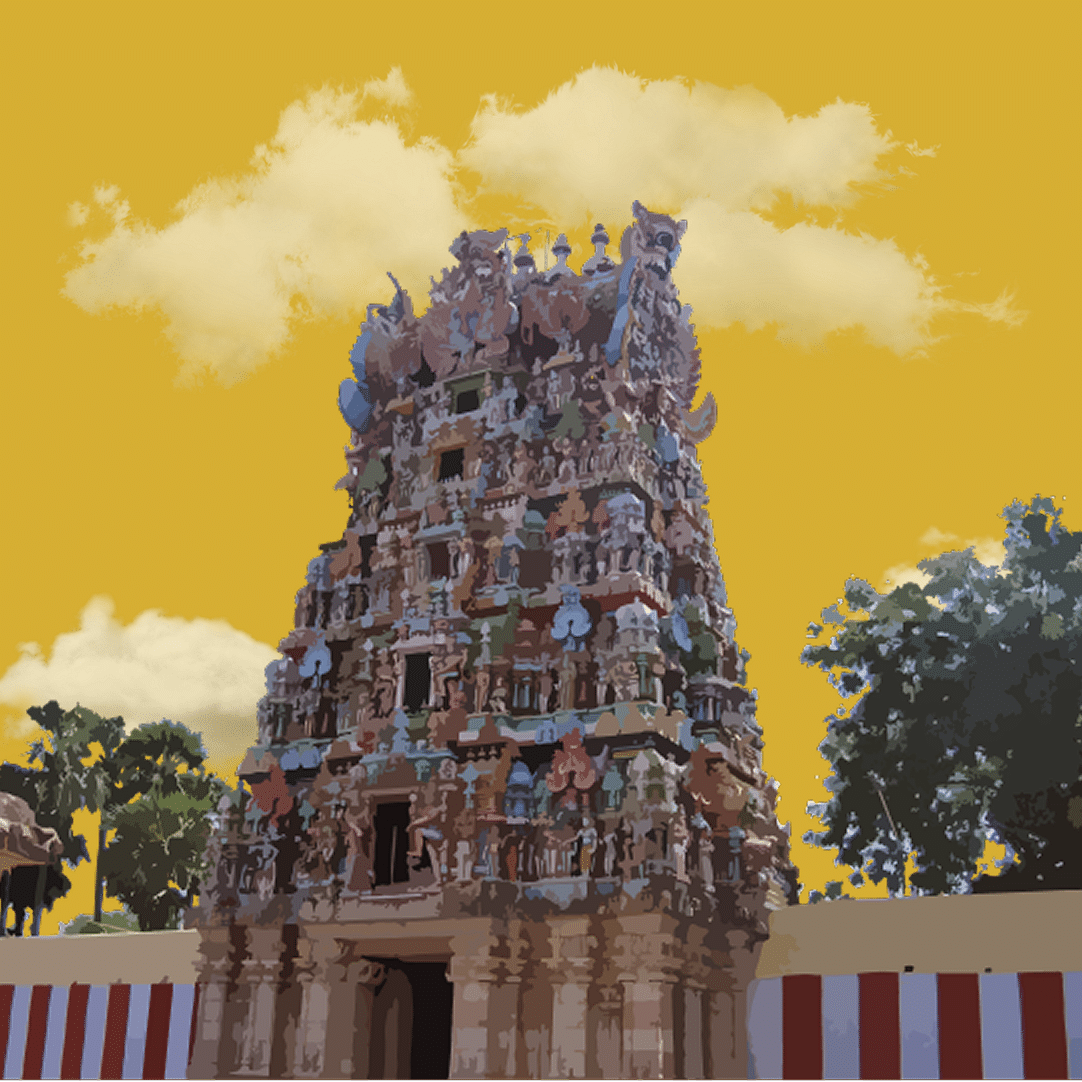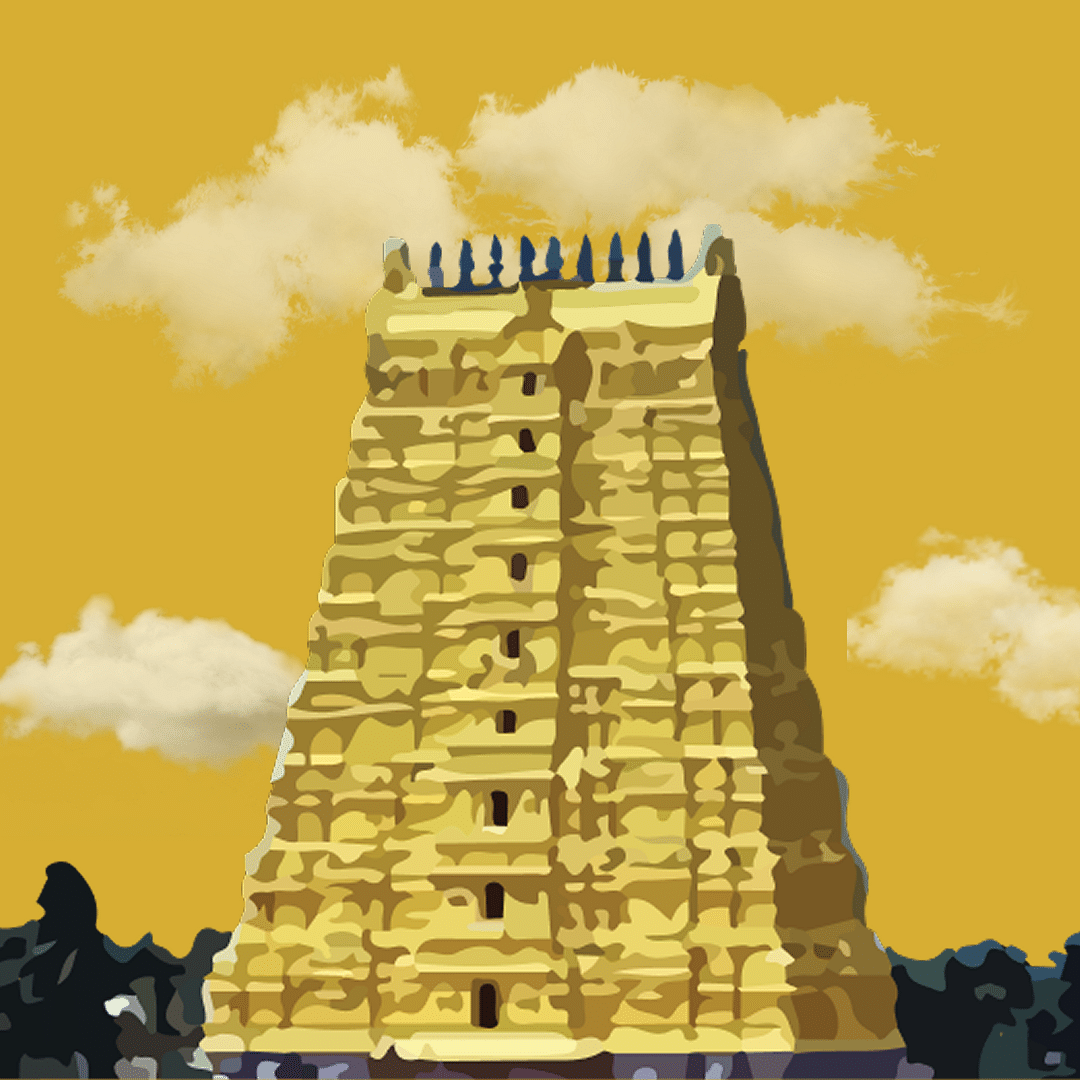Home > The GReaT Divine Darshan > Vijayawada
HOLY PLACES
IN VIJAYAWADA
Vijayawada—where the temples are taller than your ambitions and the spice levels come with no warning label. Formerly known as Bezawada (before the rebrand), this city sits between the Krishna River and Indrakeeladri Hills like it’s on a perfectly curated Instagram grid. Among the many temples in Vijayawada, the iconic Kanaka Durga Temple is the city’s crown jewel, like the Beyonce of hilltop shrines, always stealing the spotlight. Legend has it that the Goddess defeated Mahishasura here and decided to settle down—because why wouldn’t you, when your hilltop home comes with river views and a constant flow of coconuts? Even Arjuna from the Mahabharata dropped by for a quick divine power-up. Basically, Vijayawada has been the go-to place for blessings and upgrades long before 5G arrived. Crossing the Prakasam Barrage is like participating in a mini pilgrimage—half spiritual, half survival sport (especially during peak hours). And don’t even get us started on the autos—they follow GPS powered by vibes. Biryani? Hotter than a Vijayawada summer. Tiffins? So good, they should have their own temple. And the city? Growing faster than rumours during the election season. Whether you're temple-trekking, tiffin-hunting, or just trying to survive the traffic with your dignity intact, Vijayawada has one rule: go big, or go spicy.
_d82c5911)
 OUR Hotels
OUR Hotels
IN THE CITY, BY THE SACRED SITES 🏙

Grand Vijayawada by GRT Hotels
Welcome to Grand Vijayawada by GRT Hotels—where the pillows are fluffier than your weekend excuses and the spa drips are more soothing than your playlist on a rainy day. Tucked between divine darshans and delightful detours, we’re your cosy launchpad for all things Vijayawada—minus the chaos, plus all the comfort you didn’t know you needed. Wander over to the Akkanna Madanna Caves (ancient selfies, anyone?), shop for Kalamkari masterpieces, or grab a Mangalagiri saree that says, “Yes, I can chant slokas and break the internet". After a day of spicy adventures and spiritual sprints, come back to rooms so comfy, they might just ask you to adopt them. Tired? Meet our Shirodhara Spa Therapy—where warm oil gently flows over your forehead, and your worries get the hint and quietly leave the room. We’re the first in town to offer it, and trust us, even your inner chaos will take a power nap. Families, kids, pets—we welcome everyone. Even your melodramatic cat, who acts like she booked the suite herself. Whether you’re in town for temple runs, tiffin chases, or the kind of nap that heals your entire week—we’ve got the vibe, the view, and the vadais (crispy, golden, and always on point). Grand Vijayawada by GRT Hotels—where checking in feels like coming home, if home also brought you hot towels and zero chores.
 OURDivine Destinations
OURDivine Destinations
TRAVEL THROUGH THE MUSEUMS OF FAITH 🛕
_7e5c7c07)
SRI DURGA MALLESWARA SWAMY VARLA DEVASTHANAM ✨
Perched atop Indrakeeladri Hill by the Krishna River, this ancient Shakti shrine is a self-manifested symbol of divine power and Vijayawada’s spiritual heart.
Distance from Our Hotel6 km
Timing5:00 a.m. to 1:00 p.m.
5:00 p.m. to 9:00 p.m.FestivalBangle Festival: (Oct-Nov)
Shakambari: (Jun-Jul)
Navarathiri: (Oct-Nov)
Mahashivarathri: (Feb)Sacred Food OfferedLaddu, Tamarind Rice
Transportation CostFor assistance, please contact the front desk.
Disclaimer: The temple's timings are subject to change as per the operating committee's decisions.
About Sri Durga Malleswara Swamy Varla Devasthanam:
- Perched atop Indrakeeladri Hill along the banks of the River Krishna, this sacred site has been revered since ancient times and is considered a Swayambhu (self-manifested) abode of divine power.
- References in sacred texts like the Kaalika Purana and Durga Saptashati place its spiritual significance as far back as the Treta Yuga, marking it as one of the oldest known centres of Shakti worship.
- Over centuries, various dynasties, including the Eastern Chalukyas and Vijayanagara rulers, contributed to the site's development, as seen in inscriptions and structural features.
- During the ten days of Dussehra, the deity is adorned in ten unique forms, each representing different aspects of Shakti. Devotees gather in vast numbers to witness the splendour and seek blessings.
- Visitors traditionally take a ritual dip in the Krishna River before making their way up the hill, either by steps or the road, both offering panoramic views of the city below.
- The shrine has become one of the most visited pilgrimage destinations in Andhra Pradesh, playing a central role in the spiritual life of the region.
- Today, it stands not only as a symbol of victory over evil but also as an emblem of the city’s identity, deeply embedded in its culture, festivals, and folklore.
Divine Facts:
Once upon a mythical time in the Mahabharata era, Arjuna—the mightiest archer of the Pandavas and part-time seeker of divine weapons—found himself on a spiritual mission. With the Kurukshetra war looming, Arjuna wasn’t just collecting arrows—he was chasing blessings, divine boons, and celestial weaponry. And nothing short of Lord Shiva’s fearsome Pasupata Astra would do. His quest led him deep into the wilderness and finally to the serene banks of the Krishna River, at the foot of a mystical hill now known as Indrakeeladri. Here, Arjuna set up camp—not with tents and torches, but with intense tapasya (penance). No spa, no snacks, no shortcuts—just full-on devotion mode. Pleased by his grit, Lord Shiva appeared, but not in his full godly get-up. Disguised as a tribal hunter, he tested Arjuna’s strength in a duel, because what’s a divine blessing without a bit of suspense? When the cosmic dust settled and Arjuna proved his mettle, Lord Shiva revealed himself and granted the powerful Pasupata Astra, capable of reducing entire armies to ash. Overwhelmed with gratitude (and possibly still catching his breath), Arjuna built a shrine at that very spot to honour the divine energy that had blessed him. And thus began the spiritual legacy of this hill, long before concrete steps and temple bells arrived. Today, that very spot where Arjuna once meditated and worshipped is considered sacred ground, where the divine feminine energy resides in full glory, continuing to bless devotees, not with weapons, but with wisdom, strength, and unwavering courage.LAKSHMI NARASIMHA TEMPLE ✨
Set atop Agiripalli’s hill with 740 steps to climb, this 4,000-year-old Lakshmi Narasimha temple is a sacred blend of legend, devotion, and towering heritage.
Distance from Our Hotel6 km
Timing8:00 a.m. to 6:00 p.m.
FestivalBhramotsavam: (Sep-Oct)
Navarathri: (Oct-Nov)
Adhyayanathavas: (Apr-May)
Vyasa Pournami: (Jul-Jul)
Vasantha Panchami: (Jan-Feb)Sacred Food OfferedPanakkam, Lemon Rice, Pongal, Payasam, Sweets
Transportation CostFor assistance, please contact the front desk.
Disclaimer: The temple's timings are subject to change as per the operating committee's decisions.
About Lakshmi Narasimha Temple:
- According to the Puranas, the temple is believed to be around 4,000 years old, dedicated to Lakshmi Narasimha Swamy, also revered here as Sri Sobhanachaleswara Swamy.
- The temple is located in Agiripalli, approximately 25 km from Vijayawada, Andhra Pradesh.
- There is archaeological evidence suggesting the presence of the temple and its sacred tank (pushkarini) dating back to the 15th century onwards.
- In 1561 AD, a devotee is said to have arranged for the creation of a garden and Bhoga Mantapam (a pavilion for offering sacred items). Flowers from this garden were traditionally sent to the Bhadrachalam Sita Rama Swamy Temple.
- To reach the temple, devotees must climb 740 steps, as there is no ghat road available, preserving its traditional access route.
- The temple complex includes one of the tallest gopurams (temple towers) in South India, constructed by Raja Vasireddy Venkatadri Naidu, a prominent historical patron.
- The nearby Ksheera Vruksham, a sacred tree on the Mangalagiri hill, is a popular pilgrimage spot for women praying for fertility and children.
Divine Facts:
Long before selfies and status updates, the Pandavas were on a mission to seek divine grace—and Yudhishthira, the eldest and wisest of the lot, decided to take a spiritual detour. While most people collect souvenirs, Yudhishthira decided to leave behind something far more divine—a powerful idol of Sri Lakshmi Narasimha Swamy at the base of a serene hill in Mangalagiri. Talk about leaving a legacy! But the temple didn’t stop at just having divine roots. Fast forward a few centuries, and along came Raja Vasireddy Venkatadri Naidu, a king with a flair for the dramatic and a deep devotion for Lord Narasimha. He didn’t just offer coconuts and camphor—he built a 153-foot gopuram that could practically wave at the clouds. But wait—plot twist! After all that hard work, the gopuram started leaning. Panic? Nope. The clever architects from Kanchipuram suggested digging a tank opposite the tower. Result? The gopuram stood up straighter than your back in a yoga class. The temple’s main deity is none other than Narasimha, the lion-headed avatar of Vishnu, with Goddess Lakshmi by his side—because even fierce avatars need a touch of grace. The idol is decked with 108 saligramams (sacred fossil stones), and yes, there's also a legendary Dakshinavarti Shankham, believed to be Krishna’s conch shell. (Basically, the original surround sound system.) And the grandeur doesn’t stop there—there’s an ancient wooden ratha (temple chariot) with carvings so detailed, it puts modern storytelling to shame. Temples dedicated to Rajyalakshmi, Rama with Sita and Lakshmana, and even a golden Garuda vahanam are scattered around like spiritual Easter eggs. So, whether you’re in it for the divine darshan, the history, or just to climb those legendary 740 steps for a good leg day—this hill isn’t just a destination. It’s a divine chapter waiting to be experienced._0b82e12c)
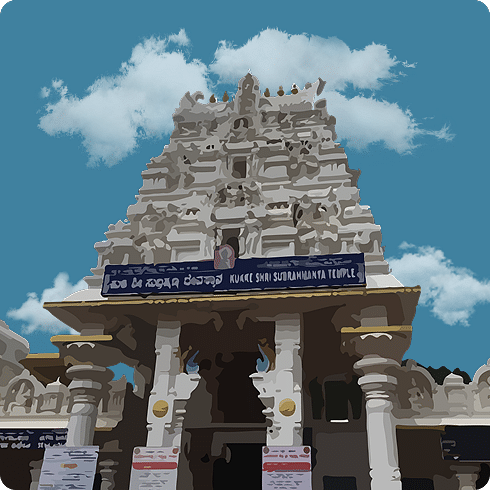
SUBRAMANYA SWAMY TEMPLE ✨
Set against the Indrakiladari Hills in Vijayawada, this sacred temple of Lord Subramanya—worshipped in three divine forms—blends ancient serpent lore, holy rivers, and intricate stonework into a revered pilgrimage destination.
Distance from Our Hotel4 km
Timing6:00 a.m. to 1:30 p.m.
3:30 p.m. to 8:00 p.m.FestivalShahsti: (Oct-Nov)
Karthigai Deepambari: (Nov-Dec)Sacred Food OfferedLaddu
Transportation CostFor assistance, please contact the front desk.
Disclaimer: The temple's timings are subject to change as per the operating committee's decisions.
About Subramanya Swamy Temple:
- This temple is located at the foot of the Indrakiladari Hills in Vijayawada, Andhra Pradesh, amidst a scenic backdrop of mountains, forests, and rivers.
- The temple is dedicated to Lord Kartikeya, revered here as the Lord of Serpents, and is worshipped in three distinct forms—as Sri Dandayudhapani Swamy (a youthful ascetic), as Sri Valli Devayanai Subramanya (in divine marital form), and as a serpent, symbolising his connection to Nagas.
- The shrine is believed to have ancient origins, although its current structure is carved from gleaming white stone, adorned with intricate carvings and elaborate stonework across its facade.
- Devotees approach the temple by first taking a holy dip in the Kumaradhara River, a traditional ritual believed to purify the soul before entering the sacred premises.
- The temple's entrance is situated at the rear, allowing devotees to circumambulate the deity, as per sacred customs.
- A prominent feature of the temple is the silver-covered Garuda pillar, which holds deep spiritual significance and is revered by pilgrims.
- An anthill beside the temple considered the natural habitat of snakes, is also worshipped with great reverence, aligning with the temple’s connection to serpent worship.
- Inside the main sanctum, the deities Lord Subramanya and Shesha (the divine serpent) are enshrined and worshipped daily by devotees from across the country.
- Over time, the temple has grown in popularity, becoming a significant pilgrimage destination for worshippers of Lord Subramanya.
Divine Facts:
After triumphing over the fearsome demons Tarakasura and Surapadmasura, Lord Shanmukha made his way to Kumara Parvatha with his brother Ganesha, marking the end of a divine mission and the beginning of a divine celebration. As the celestial drums of victory faded, Indra, king of the heavens, arrived with gratitude in his heart and a proposal in hand—he offered his daughter Devasena in marriage to the victorious Lord. The wedding was scheduled for Margashira Shuddha Shashti, and it wasn't just a small ceremony with garlands and hymns—it was the kind of divine event where even the rivers showed up. Yes, waters from countless holy rivers descended to bless the occasion, and in the midst of this sacred gathering, the stream now known as Kumaradhara was formed. Even the Mahabhisheka, the grand sacred bath, decided to join in, flowing down in devotion and grace. Meanwhile, in the Biladwara caves, the noble Serpent King Vasuki was deep in penance. Not to escape attention, but to avoid the sharp-eyed pursuits of Garuda, the mighty bird mount of Lord Vishnu. Vasuki’s devotion was intense—years passed, and not a single day did his resolve waver. Moved by his unwavering focus, Lord Shanmukha appeared before him, granting him the highest honour—declaring Vasuki as his foremost devotee. Since then, worshipping Vasuki has been considered equivalent to worshipping Lord Subramanya himself. And thus, between divine battles, holy rivers, and a serpent’s unshakeable devotion, the legend of the Subramanya Swamy Temple was etched in time.AKKANNA MADANNA TEMPLE ✨
Set in the heart of Vijayawada, the Akkanna Madanna Temple stands as a divine tribute to two devoted brothers and their unwavering faith in Goddess Mahakali revived from obscurity after centuries.
Distance from Our Hotel6 km
Timing9:00 a.m. to 6:00 p.m.
Transportation CostFor assistance, please contact the front desk.
Disclaimer: The temple's timings are subject to change as per the operating committee's decisions.
About Akkanna Madanna Temple:
- This temple is a revered Hindu temple dedicated to Goddess Mahakali, located in Hyderabad, Telangana, India.
- The temple was established in the mid-17th century, during the reign of Nawab Abdullah Qutb Shah, the ruler of the Golconda Sultanate.
- It was named in honour of Akkanna and Madanna, two courageous brothers and influential ministers in the court of the Nawab, known for their administrative brilliance and devotion to Hindu causes.
- The temple was constructed in traditional Dravidian architectural style, featuring intricately carved pillars, ceilings, and walls that depict various deities and mythological tales.
- Within the temple premises are several sub-shrines, and the central tower is adorned with sculptures of both major and minor Hindu gods and goddesses.
- Over time, the temple grew in popularity as a centre for worshipping Goddess Mahakali, attracting devotees seeking divine blessings for both personal and professional well-being.
- The temple strictly adheres to Vedic rituals and practices, with daily pujas, archanas, and ceremonies performed with great discipline and precision.
- It plays a significant role during the Bonalu festival, a major religious event in Hyderabad and Secunderabad, where the temple becomes a hub of devotional activity.
- The temple is especially known for the Ghatam procession during Bonalu, where an earthen pot decorated with turmeric and neem leaves is carried in a grand ritual procession.
- In addition to its religious significance, the temple stands as a historical symbol of resistance and revival of Hindu traditions during a period of Islamic rule in the Deccan.
Divine Facts:
Back in the early 17th century, when kings still ruled from forts and not from air-conditioned boardrooms, Hyderabad was under the reign of King Tana Shah. His fort of choice? The majestic Golkonda Fort, where decisions were made, secrets were whispered, and ministers tried very hard to not get fired. Among his favourites were two brilliant brothers—Akkanna, the Prime Minister, and Madanna, the Commander-in-Chief. These weren’t your average power-suited bureaucrats—they were devotees of Mahakali with day jobs in royal administration. Every morning, before diving into empire matters, they’d stop by a humble shrine dedicated to Goddess Mahakali, offering prayers and probably mentally preparing for a long day of palace politics. Their house was conveniently close to the temple. Their devotion wasn’t just a morning ritual; it was a way of life. Mahakali wasn’t just a goddess to them—she was their anchor, their protector, their guide. But as with any story involving power and piety, things took a dramatic turn. The brothers, despite their wisdom and popularity, were killed by political rivals who couldn’t stomach their influence. The temple, once buzzing with devotion, fell silent—its doors shut, its stones left to gather dust and silence. For decades, the once-revered shrine lay hidden in Hari Bowli, beneath the growing chaos of city life. People walked past it, unaware that history, divinity, and legacy lay buried beneath their feet—quite literally. But as Mahakali would have it, divine shrines don’t stay forgotten for long. Nearly 67 years ago, the temple rose again from the debris, like a phoenix in full goddess form. The once-forgotten abode of Mahakali was brought back to life. Today, the Akkanna Madanna Temple doesn’t just echo with chants and bells during Bonalu—it also tells a story of two devoted brothers, divine loyalty, and a city that remembered what once slipped through its fingers.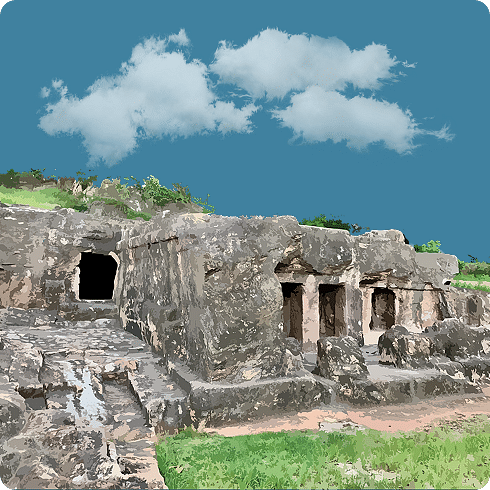

HRINKAR THEERTH ✨
Established in 2013, Hrinkar Theerth in Vijayawada is a serene Jain pilgrimage site dedicated to spiritual growth, non-violence, and devotion through the sacred Hrinkar mantra.
Distance from Our Hotel21 km
Timing6:00 a.m. to 9:00 p.m.
FestivalParyushan: (Aug)
Mahavir Jayanti: (Apr)
Diwali: (Oct-Nov)Transportation CostFor assistance, please contact the front desk.
Disclaimer: The temple's timings are subject to change as per the operating committee's decisions.
About Hrinkar Theerth:
- Hrinkar Theerth is a renowned Jain pilgrimage centre located in Vijayawada, Andhra Pradesh, and holds spiritual significance for Jain devotees from across India and abroad.
- The word Hrinkar refers to the Hrinkar mantra, which is chanted here as part of spiritual practices, symbolising deep devotion and the pursuit of enlightenment.
- The concept of establishing a sacred Jain site in Vijayawada was initiated in 2013 by the local Jain community, with the vision of creating a peaceful space for prayer, meditation, and the promotion of Jain values.
- Initially a modest spiritual retreat, the theerth has grown steadily through community support, transforming into a major centre of worship and learning over the years.
- The tranquil surroundings of Hrinkar Theerth have made it a focal point for meditation, spiritual study, and the observance of Jain principles such as non-violence, compassion, and truth.
- It hosts various Jain festivals and religious ceremonies, attracting devotees who gather for communal prayer, rituals, and spiritual discourse.
- The development of this theerth not only signifies the dedication of the Jain community but also reflects Vijayawada’s cultural diversity and acceptance of multiple religious traditions.
- Today, Hrinkar Theerth stands as a serene spiritual haven and a symbol of faith, harmony, and Jain heritage, offering a space for reflection and inner growth.

_7e5c7c07)
